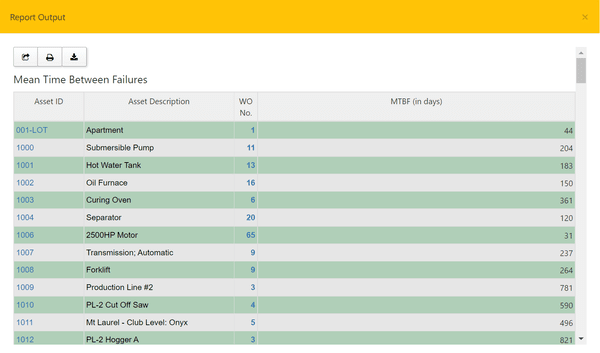Mean Time Between Failures (MTBF) is a common metric used to assess equipment reliability. It represents the average time, typically in hours, that an asset, component, or system will operate before a breakdown.
Mean time between failures is a crucial metric for any industry where equipment failure can lead to costly downtime, compliance issues, or safety concerns. In this article, we’ll discuss the meaning of MTBF and how to calculate it, as well as outline strategies for improving MTBF.
What is Mean Time Between Failures (MTBF)?
Mean time between failures measures the expected productive life of a system, an asset, or a component. It estimates the average length of time that equipment operates between failures.
MTBF is a crucial metric for helping businesses track equipment availability. It’s also a useful way to assess a plant or facility’s overall reliability.
Tracking MTBF helps maintenance managers plan and schedule maintenance tasks more effectively. Used correctly, MTBF can also help managers assess when an asset will need to be maintained.
That means that assets promptly get the maintenance they need to stay up and running, resulting in much less downtime. It also means that teams don’t waste resources performing unnecessary maintenance.
MTBF Calculation: What is the Formula for MTBF?
Don’t rely on a manufacturer’s estimate to find an asset’s MTBF. Mean time between failures is highly variable and depends on the asset’s specific operating conditions, utilization, and other factors. It’s essential to calculate MTBF based on the precise data obtained directly from your assets.
To calculate MTBF, you’ll need to know the total number of hours a machine or component has been operational. You’ll also need to know the number of times the asset has failed over that time.
Finally, divide the asset’s total operational hours by the number of times it failed in that period.
The formula used to calculate Mean Time Between Failure (MTBF) is:
Hours of Operation / Number of Failures = MTBF
For example, if a pump runs for 1,000 hours and breaks down four times, its MTBF would be calculated as 1000 / 4 = 250. The Mean Time Between Failure for this pump would be 250 hours.
The MTBF formula is simple, but it requires plenty of accurate data. That’s why digital tools, like a Computerized Maintenance Management System (CMMS), can be such a game changer for tracking MTBF and other metrics.
CMMS software acts as a centralized repository for all a plant’s data, such as operational hours and the number of failures. Having all that data in one easy-to-access location makes calculating MTBF a breeze.
CMMS also makes it easy to access the data you need remotely. It also automatically tracks many metrics so that you can quickly see trends over time, making it easier to manage asset lifecycles and inventory.
Why Is it Important to Calculate MTBF?
MTBF is an important metric for maintenance teams to track as they work to reduce downtime and extend asset lifespans. Knowing the mean time between failures gives maintenance managers insights into asset health, helping them make informed predictions about future maintenance needs.
The cost of unplanned downtime can be devastating. But the more you know about MTBF, the more easily you can avoid breakdowns.
Tracking MTBF helps teams:
- Pinpoint areas of risk and plan strategies to protect critical assets
- Assess the effectiveness of maintenance strategies and workflows
- Make informed decisions about replacing or repairing equipment
- Improve inventory and spare parts management
How to Improve MTBF
There are a few key ways to increase an asset’s MTBF.
First, ensure that your data is accurate by using a trustworthy system such as a CMMS. You need plenty of precise and reliable data to ensure your metrics are accurate.
Next, put your metrics to work. Use the calculated MTBF to create a tailored preventive maintenance plan for each asset. You now have a good idea of when your equipment should fail, so plan the necessary maintenance before that time.
When equipment fails, it’s best practice to perform root cause analysis. Done right, root cause analysis can help you understand the underlying problem causing your asset to fail. This will help you pinpoint exactly what maintenance tasks your team needs to do to prevent future failures.
Finally, implementing a predictive maintenance program is one of the best ways to improve MTBF. Predictive maintenance leverages condition monitoring data to identify asset faults at the earliest stages — long before they lead to a breakdown.
Predictive maintenance can be considered an early warning system that protects against machine failure and improves the mean time between failures.
A good CMMS — like eMaint — can help improve MTBF by facilitating data collection, helping set maintenance priorities, and analyzing condition monitoring data. The result is a streamlined predictive maintenance approach that leads to greater efficiency and a sharp reduction in downtime.
Speak with a specialist to learn how a CMMS can help track maintenance KPIs and condition monitoring sensors can help avoid downtime altogether.


